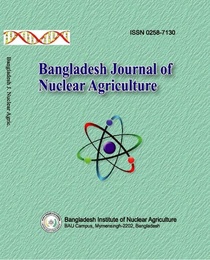WATERLOGGED TOLERANCE OF SESAME GENOTYPES ON THE BASIS OF MORPHO-ANATOMICAL FEATURESAND YIELD
Abstract
Waterlogging is an environmental factor that reduces gas exchange between plant tissues and the atmosphere and limits plant growth and yield and damages root and shoot structures. A pot experiment was conducted with four sesame genotypes viz. Rajshahi Khoyeri, Kistotil Chapai, Kathtil Chapai and Binatil-2 during March to June 2019. Four waterlogged treatments viz. Control, 24, 48 and 72 hours were imposed at flowering stage of the sesame genotypes. Plant height, shoot and root dry weight, total dry matter plant-1, capsules plant-1, number of seeds capsule-1, number of seeds plant-1, 1000-seed weight and seed yield plant-1 were significantly decreased with increasing water logging periods. Rajshahi Khoyeri produced the highest seed yield followed by Kathtil Chapai. Total dry matter reduction was less in Rajshahi Khoyeri and yield reduction was less in Kathtil Chapai under different water logging treatments. Root and stem anatomy of all the genotypes was investigated under control and 72 hours water logging and found that water logging at 72 hours partially damaged its epidermis, hypodermis and vascular bundle and adventitious roots were formed to help storage and exchange of gases within stressed plants to maintain a hypoxia tolerance pathway for survival.
References
Atkinson, N.J., Lilley, C.J. and Urwin, P.E. 2013. Identification of genes involved in the response of Arabidopsis to simultaneous biotic and abiotic stresses. Plant Physiol. 162(4), 2028-2041.
Bedigian, D. 2004. History and lore of sesame in southwest asia. Econ. Bot. 58: 329-353.
Capon, S.J., Jamesb, C.S., Williams, L. and Quinnc, G.P. 2009. Response to flooding and drying in seedlings of a common Australian desert floodplain shrub: MuehlenbeckiaflorulentaMeisn, Eviron. Exp. Bot. 66: 178-185.
Chugh, V., Gupta, A.K., Grewal, M.S. and Kaur, N. 2012. Response of antioxidative and ethanolic fermentation enzymes in maize seedlings of tolerant and sensitive genotypes under short-term water logging. Indian J. Exp. Biol. 50: 577-582.
Evans, D.E. 2003. Aerenchyma formation, New phytol. 161: 35-49.
Grassini, P., Indiaco, G.V., Pereira, M.L., Hall, A.J. and Trapani, N. 2007. Responces to short-term water logging during grain filling of sunflower. Field Crops Res. 101: 352-363.
Islam, M.T. andKhatoon, M. 2018. Morpho-physiological parameters and yield of some sesame land races under different water logging period. Int. J. Expt. Agric. 8(1), 10-14.
Islam, M.T., Khatoon, M., Haque, M.A. and Rahman, M. S. 2017. Photosynthesis and yield performance of sesame genotypes under different water logging period. Int. J. Sustain Crop Prod. 12(1), 15-19.
Jackson, M.B. and Colmer, T.D. 2005. Response and adaptation by plants to flooding stress. Ann. Bot. 96: 501-505.
Justin, S. H. F. W. and Armstrong, W. 1987. The anatomical characteristics of roots and plant response to soil flooding, New phytol. 106: 465-495.
Komatsu, S., Yamamoto, R., Nanjo, Y., Mikami, Y., Yunokawa, H. and Sakata, K. 2009. A comprehensive analysis of the soybean genes and proteins expressed under flooding stress using transcriptome and proteome techniques. J Proteome Res. 8(10): 4766-4778.
Miro, B. and Ismail, A. M. 2013. Tolerance of anaerobic conditions caused by flooding during germination and early growth in rice (Oryza sativa L.). Frontiers Plant Sci. 4:269.
Mondal, N., Bhat, K.V. and Srivastava, P.S. 2010. Variation in Fatty Acid Composition in Indian Germplasm of Sesame. J Am Oil Chem Soc. 87(11):1263-1269.
Nakano, D., Kwak, C.J., Fujii, K., Ikemura, K., Satake, A. and Ohkita, M. 2006. Sesamin metabolites induce an endothelial nitric oxide-dependent vasorelaxation through their antioxidative property-independent mechanisms: possible involvement of the metabolites in the antihypertensive effect of sesamin. J. Pharmacol. Exp.Ther. 318(1): 328–335.
Nakashima, K., Ito, Y. and Yamaguchi-Shinozaki, K. 2009. Transcriptional regulatory networks in response to abiotic stresses in Arabidopsis and grasses. Plant Physiol. 149(1), 88-95.
Ram, R., Catlin, D., Romero, J. and Cowley, C. 1990. Sesame: New approaches for crop improvement In: Janic J., Simon, J.E., ed. Advances in new crops. Timber, Portland, p. 225-228.
Rasmussen, S., Barah, P., Suarez-Rodriguez, M.C., Bressendorff, S., Friis, P. and Costantino, P. 2013. Transcriptome responses to combinations of stresses in Arabidopsis. Plant Physiol. 161(4):1783–1794.
Sachs, M. M., Freeling, M. and Okimoto, R. 1980. The anaerobic proteins of maize. Cell. 20(3): 761-767.
Wei, W., Li, D., Wang, L., Ding, X., Zhang, Y., Gao, Y. and Zhang, X. 2013. Morpho-anatomical and physiological responses to water logging of sesame (Sesamum indicum L.). Plant Sci. 208: 102-111.
-
Download



